1.Lambda表达式
介绍


使用
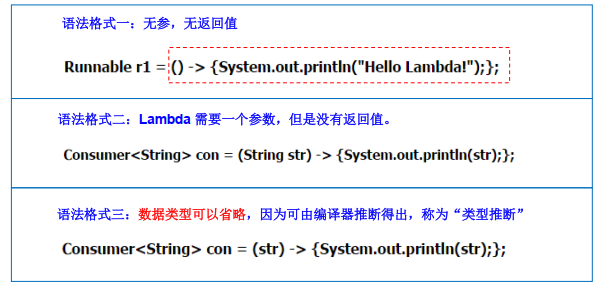
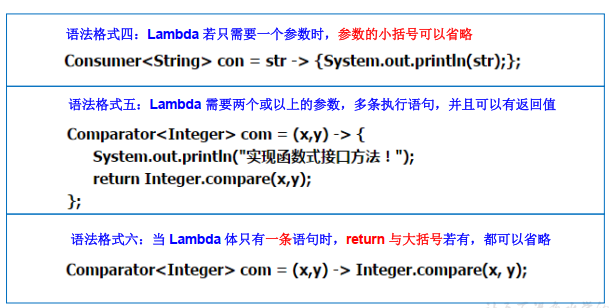
// 1.无参,无返回值
Runnable r1 = new Runnable() { //匿名内部类
@Override
public void run() {
System.out.println("我爱njupt");
}
};
Runnable runnable = () -> System.out.println("你好");
// 2.只需一个参数,但没有返回值
Consumer<String> consumer1 = new Consumer<String>() {
@Override
public void accept(String s) {
System.out.println(s);
}
};
consumer1.accept("666");
Consumer<String> consumer2 = (str) -> { //参数str的String类型可以省略不写
System.out.println(str);
};
consumer2.accept("666");
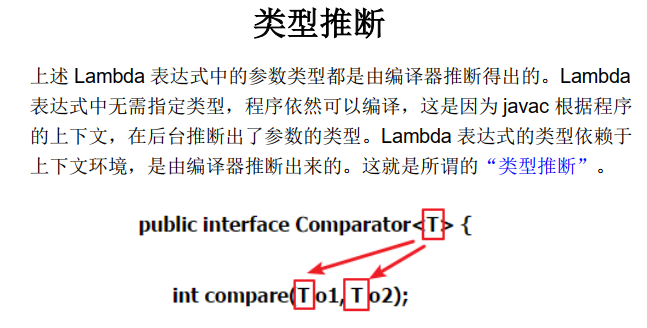
类似的类型推断有:
ArrayList<Integer> arrayList = new ArrayList<>(); //后面<>可不写,因为类型推断
int[] arr = new int[]{1,2,3,4};
int[] arr = {1, 2, 3, 4}; //类型推断
2.函数式接口
介绍

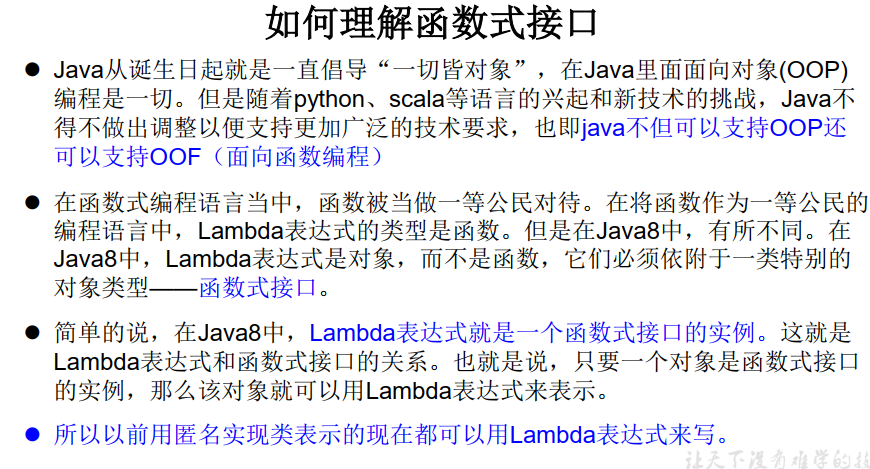
// 自定义函数式接口
@FunctionalInterface
public interface myInterFace {
void run(); // 只包含一个抽象方法
}
四大核心函数式接口
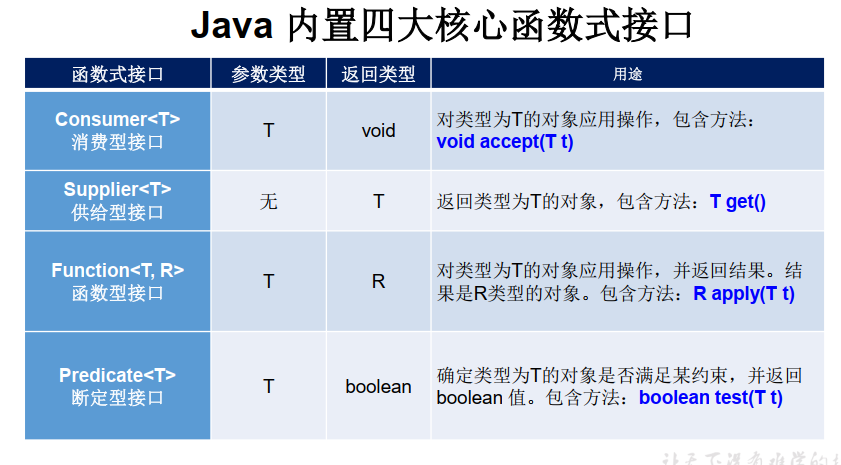
@Test
public void test01() {
List<String> list = Arrays.asList("北京", "天津", "南京", "味精");
//1.不用lambda
// List<String> filterString = filterString(list, new Predicate<String>() {
// @Override
// public boolean test(String s) {
// return s.contains("京");
// }
// });
// System.out.println(filterString);
//2.使用lambda
List<String> filterString = filterString(list, s -> s.contains("京"));
System.out.println(filterString);
}
public static List<String> filterString(List<String> list, Predicate<String> pre) {
ArrayList<String> filterList = new ArrayList<>();
for (String s : list) {
if(pre.test(s)) {
filterList.add(s);
}
}
return filterList;
}
其他接口
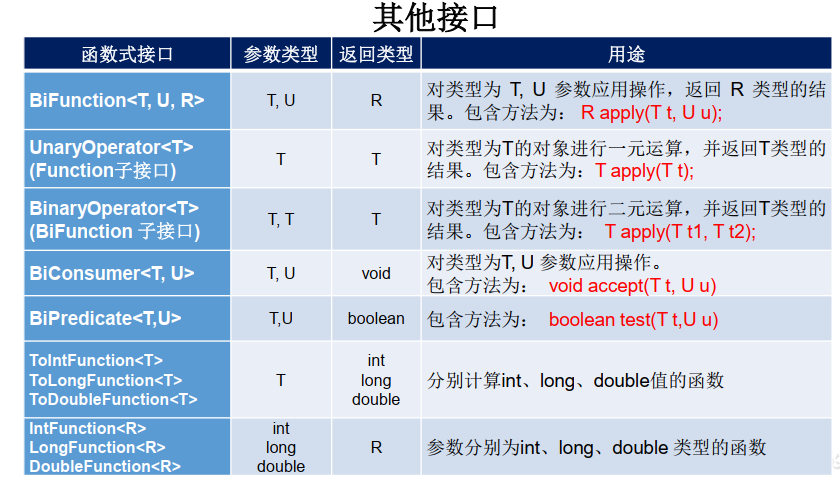
3.方法引用、构造器引用
介绍
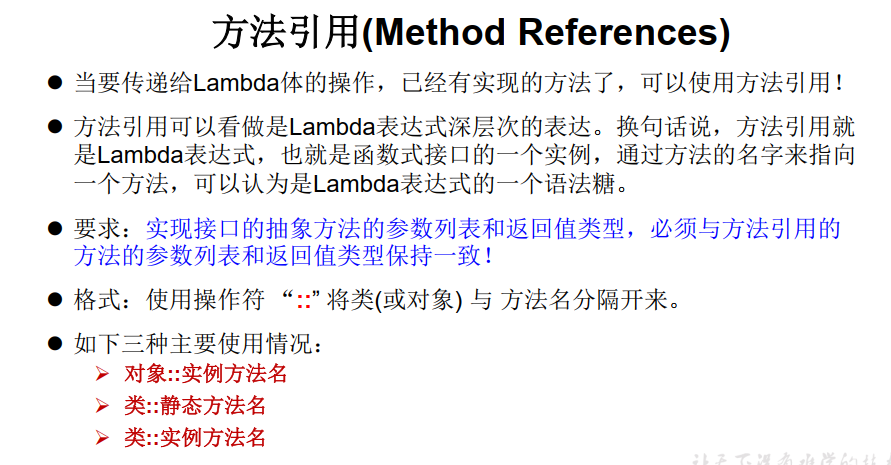
使用
// 情况一:对象 :: 实例方法
//Consumer中的void accept(T t)
//PrintStream中的void println(T t)
@Test
public void test1() {
Consumer<String> con1 = str -> System.out.println(str);
con1.accept("我爱njupt");
System.out.println("******************************");
PrintStream ps = System.out;
Consumer<String> con2 = ps::println;
con2.accept("我爱njupt");
}
//Supplier中的T get()
//Employee中的String getName()
@Test
public void test2() {
Person person = new Person(10, "ckz");
Supplier<String> con = () -> person.getName();
System.out.println(con.get());
Supplier<String> con2 = person::getName;
System.out.println(con2.get());
}
// 情况二:类 :: 静态方法
//Comparator中的int compare(T t1,T t2)
//Integer中的int compare(T t1,T t2)
@Test
public void test3() {
Comparator<Integer> con = (x1, x2) -> Integer.compare(x1, x2);
System.out.println(con.compare(12, 21));
Comparator<Integer> con2 = Integer::compare;
System.out.println(con2.compare(12, 21));
}
//Function中的R apply(T t)
//Math中的Long round(Double d)
@Test
public void test4() {
Function<Double, Long> func = d -> Math.round(d);
System.out.println(func.apply(4.5));
Function<Double, Long> func2 = Math::round;
System.out.println(func2.apply(4.5));
}
// 情况三:类 :: 实例方法 (有难度)
// Comparator中的int comapre(T t1,T t2)
// String中的int t1.compareTo(t2)
@Test
public void test5() {
Comparator<String> com1 = (s1, s2) -> s1.compareTo(s2);
System.out.println(com1.compare("ffc", "ffa"));
Comparator<String> com2 = String::compareTo;
System.out.println(com2.compare("ffc", "ffa"));
}
//BiPredicate中的boolean test(T t1, T t2);
//String中的boolean t1.equals(t2)
@Test
public void test6() {
BiPredicate<String,String> pre1 = (s1, s2) -> s1.equals(s2);
System.out.println(pre1.test("abc","abc"));
System.out.println("*******************");
BiPredicate<String,String> pre2 = String :: equals;
System.out.println(pre2.test("abc","abd"));
}
注意
针对情况1和情况2:使用方法引用时,要求接口中的抽象方法的形参列表和返回值类型 与 方法引用的方法的形参列表和返回类型相同。
针对情况3:当函数式接口方法的第一个参数是需要引用方法的调用者,并且第二个参数是需要引用方法的参数(或无参数)时:ClassName:methodName
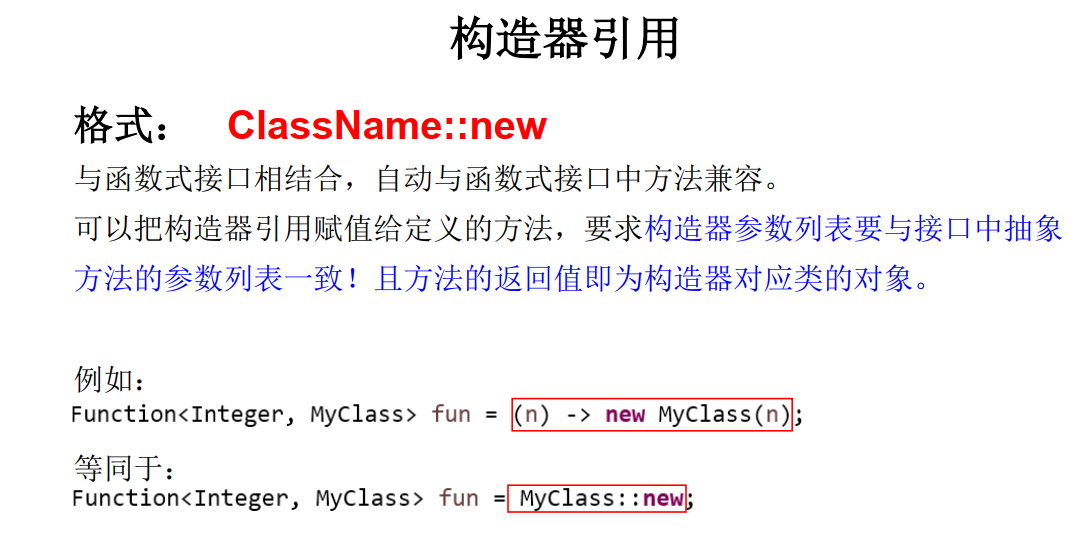
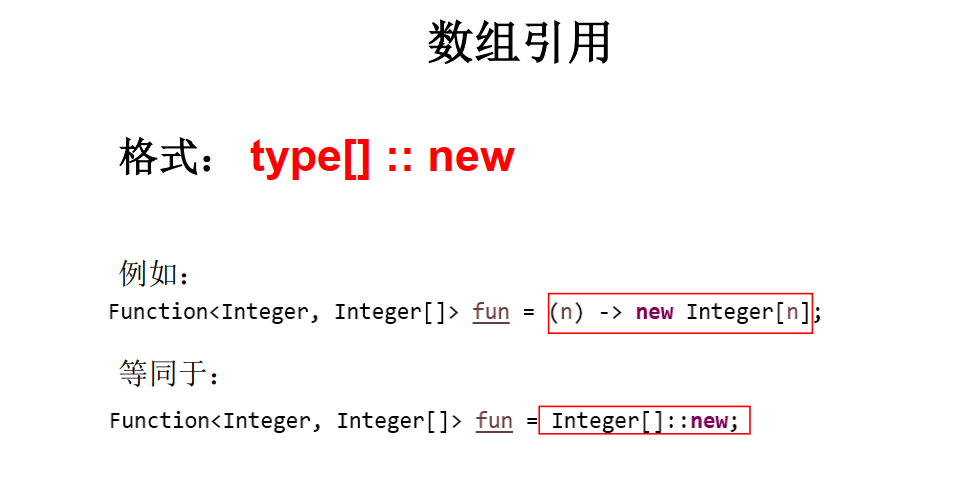
//构造器引用
//Supplier中的T get()
//Employee的空参构造器:Employee()
@Test
public void test1() {
Supplier<Person> sup1 = () -> new Person();
System.out.println(sup1.get());
Supplier<Person> sup2 = Person::new;
System.out.println(sup2.get());
}
//BiFunction中的R apply(T t,U u)
@Test
public void test2() {
BiFunction<String, Integer, Person> bif1 = (age, name) -> new Person(age, name);
System.out.println(bif1.apply("czk", 11));
BiFunction<String, Integer, Person> bif2 = Person::new;
System.out.println(bif2.apply("czk", 11));
}
//数组引用
//Function中的R apply(T t)
@Test
public void test3() {
Function<Integer, String[]> func1 = length -> new String[length];
String[] arr1 = func1.apply(5);
System.out.println(arr1);
Function<Integer, String[]> func2 = String[]::new;
String[] arr2 = func1.apply(5);
System.out.println(arr2);
}
4.强大的StreamAPI
介绍

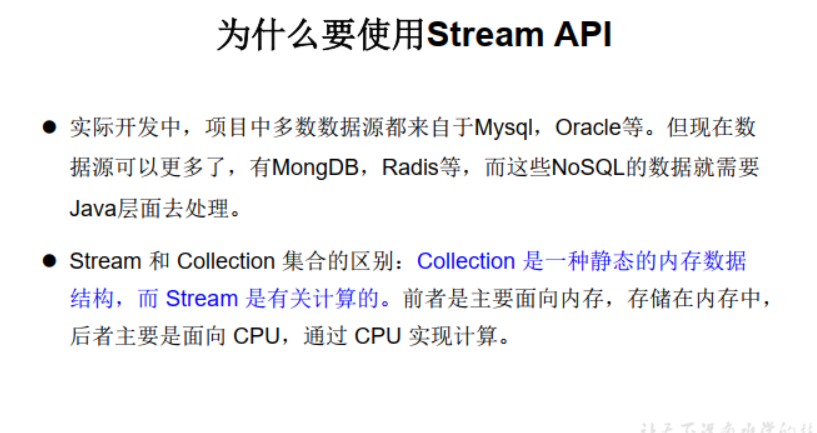
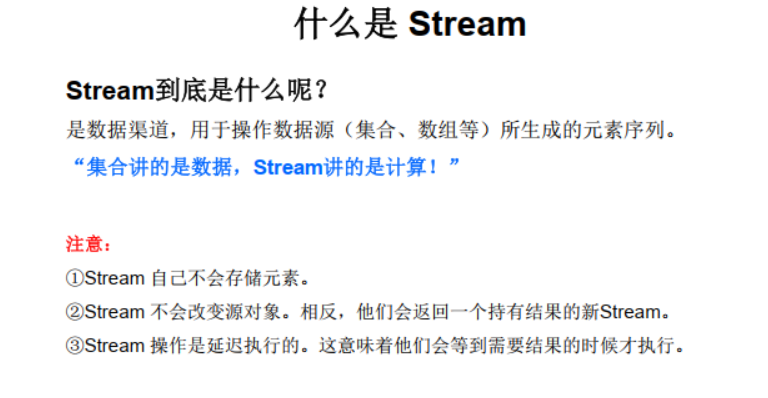
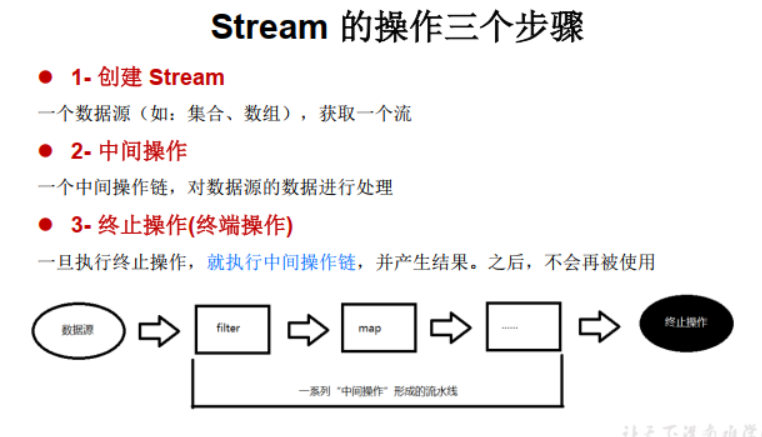
创建Stream的几种方式
//创建 Stream方式一:通过集合
@Test
public void test1() {
List<Employee> employees = EmployeeData.getEmployees();
//default Stream<E> stream() : 返回一个顺序流
Stream<Employee> stream = employees.stream();
//default Stream<E> parallelStream() : 返回一个并行流
Stream<Employee> parallelStream = employees.parallelStream();
}
//创建 Stream方式二:通过数组
@Test
public void test2() {
int[] arr = {1, 2, 3, 4, 5, 6};
//调用Arrays类的static <T> Stream<T> stream(T[] array): 返回一个流
IntStream stream = Arrays.stream(arr);
}
//创建 Stream方式三:通过Stream的of()
@Test
public void test3() {
Stream<Integer> stream = Stream.of(1, 2, 3, 4, 5);
}
//创建 Stream方式四:创建无限流 (主要用于创造数据)
@Test
public void test4(){
// 迭代
// public static<T> Stream<T> iterate(final T seed, final UnaryOperator<T> f)
//遍历前10个偶数
Stream.iterate(0, t -> t + 2).limit(10).forEach(System.out::println);
// 生成
// public static<T> Stream<T> generate(Supplier<T> s)
Stream.generate(Math::random).limit(10).forEach(System.out::println);
}
Stream的中间操作
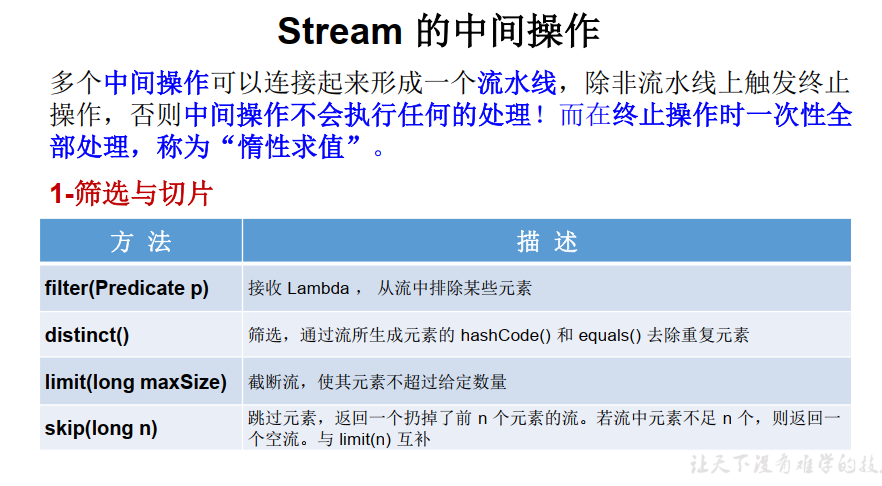
//筛选与切片
@Test
public void test1() {
List<Employee> employees = EmployeeData.getEmployees();
Stream<Employee> stream = employees.stream();
//filter(Predicate p)——接收 Lambda , 从流中排除某些元素。
// forEach(Consumer<? super T> action)
stream.filter(e -> e.getSalary() > 5000).forEach(System.out::println);
System.out.println();
// limit(n)——截断流,使其元素不超过给定数量。
employees.stream().limit(3).forEach(System.out::println);
System.out.println();
//skip(n) —— 跳过元素,返回一个扔掉了前 n 个元素的流。若流中元素不足 n 个,则返回一个空流。与 limit(n) 互补
employees.stream().skip(3).forEach(System.out::println);
System.out.println();
employees.add(new Employee(1010, "czk", 23, 250000));
employees.add(new Employee(1010, "czk", 23, 250000));
employees.add(new Employee(1010, "czk", 23, 250000));
employees.add(new Employee(1010, "czk", 23, 250000));
employees.add(new Employee(1010, "czk", 23, 250000));
//distinct()——筛选,通过流所生成元素的 hashCode() 和 equals() 去除重复元素
employees.stream().distinct().forEach(System.out::println);
}
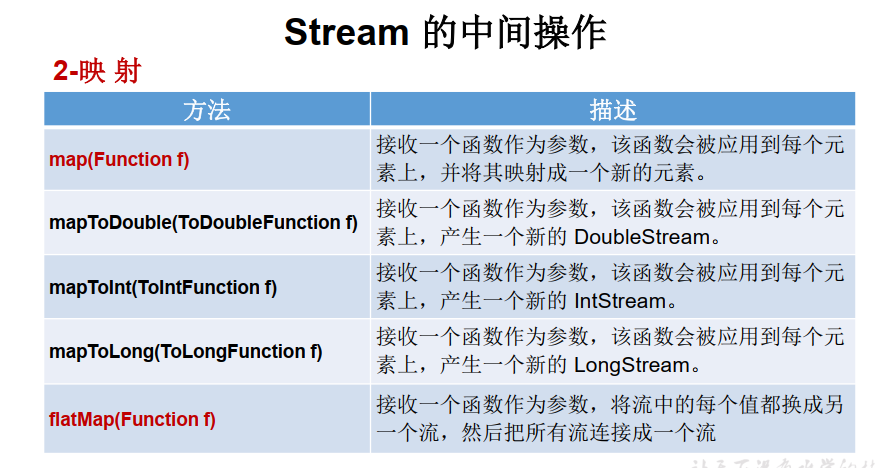
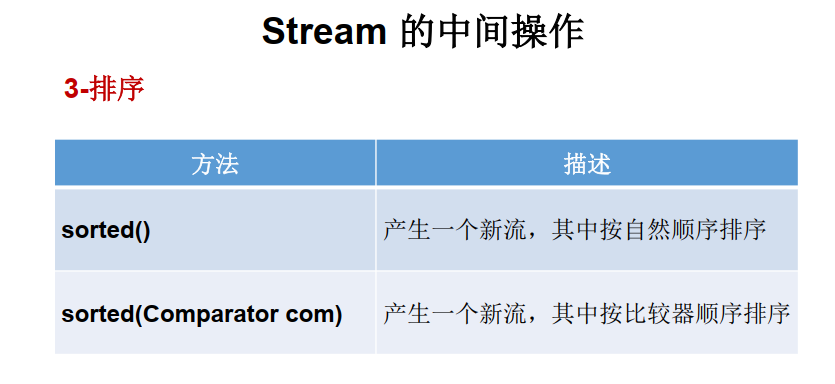
//映射
@Test
public void test2() {
//map(Function f)——接收一个函数作为参数,将元素转换成其他形式或提取信息,该函数会被应用到每个元素上,并将其映射成一个新的元素。
List<String> list = Arrays.asList("aa", "bb", "cc");
list.stream().map(str -> str.toUpperCase()).forEach(System.out::println);
//练习1:获取员工姓名长度大于3的员工的姓名。
List<Employee> employees = EmployeeData.getEmployees();
Stream<String> nameStream = employees.stream().map(Employee::getName);
nameStream.filter(str -> str.length() > 3).forEach(System.out::println);
}
//排序
@Test
public void test3() {
List<Integer> arrayList = Arrays.asList(12, 31, 21);
arrayList.stream().sorted().forEach(System.out::println);
System.out.println();
//自定义排序
List<Employee> employees = EmployeeData.getEmployees();
employees.stream().sorted((e1, e2) -> {
int ageValue = Integer.compare(e1.getAge(), e2.getAge());
if(ageValue != 0) {
return ageValue;
}else {
return Double.compare(e1.getSalary(), e2.getSalary());
}
}).forEach(System.out::println);
}
终止操作
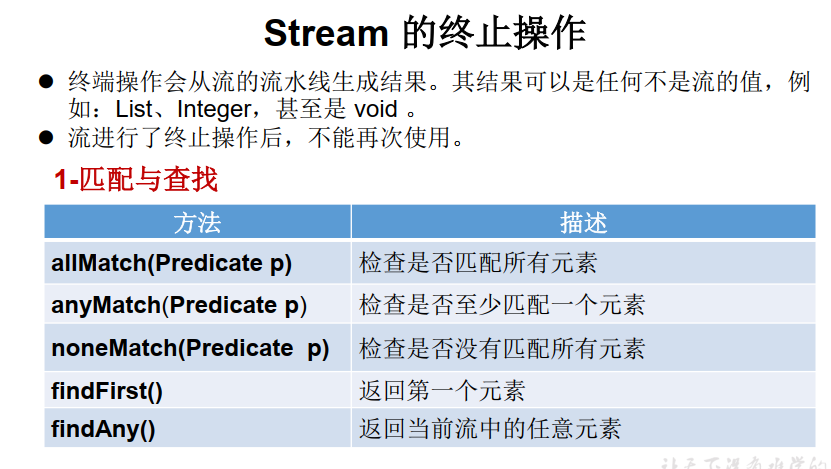
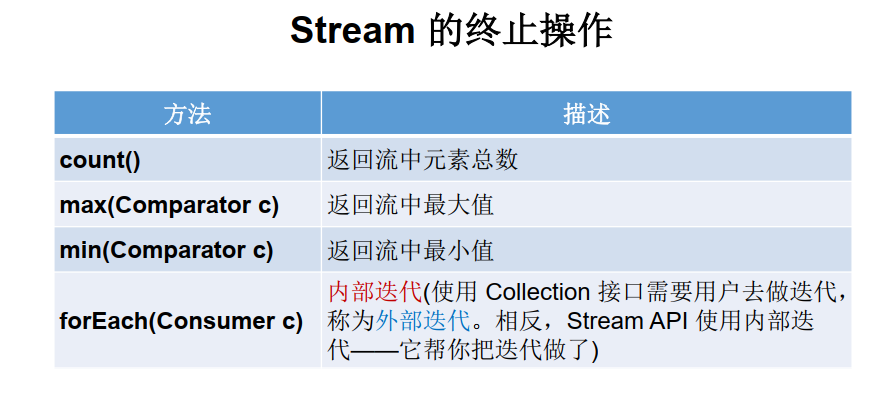
//匹配和查找
@Test
public void test1() {
List<Employee> employees = EmployeeData.getEmployees();
//allMatch(Predicate p)——检查是否匹配所有元素。
boolean b = employees.stream().limit(3).allMatch(e -> e.getSalary() > 3000);
System.out.println(b);
//findFirst——返回第一个元素 返回类型为Optional类型
Optional<Employee> first = employees.stream().findFirst();
System.out.println(first);
long count = employees.stream().count();
System.out.println(count);
//max(Comparator c)——返回流中最大值 类型为Optional
Optional<Employee> employee1 = employees.stream().max((e1, e2) -> {
return Double.compare(e1.getSalary(), e2.getSalary());
});
System.out.println(employee1);
}
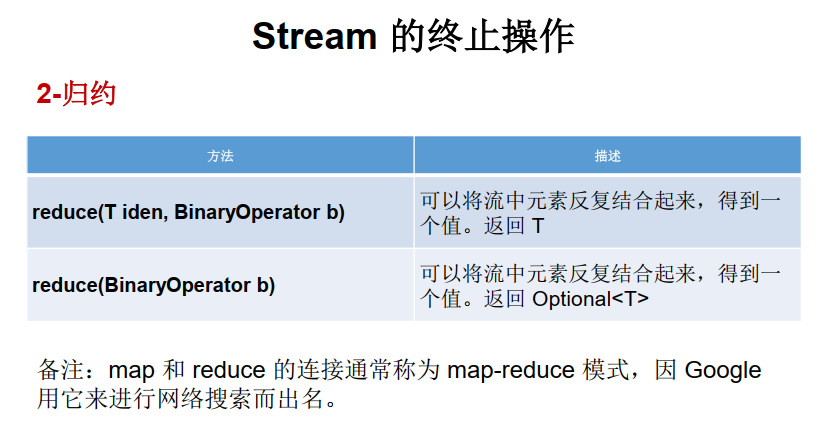
@Test
public void test2() {
//reduce(T identity, BinaryOperator)——可以将流中元素反复结合起来,得到一个值。返回 T
//BinaryOperator<T,T,T>
List<Integer> list = Arrays.asList(1, 2, 5, 3);
Integer sum = list.stream().reduce(0, Integer::sum);
System.out.println(sum);
//练习2:计算公司所有员工工资的总和
List<Employee> employees = EmployeeData.getEmployees();
Stream<Double> salaryStream = employees.stream().map(Employee::getSalary);
Optional<Double> sumMoney = salaryStream.reduce(Double::sum);
System.out.println(sumMoney.get());
}
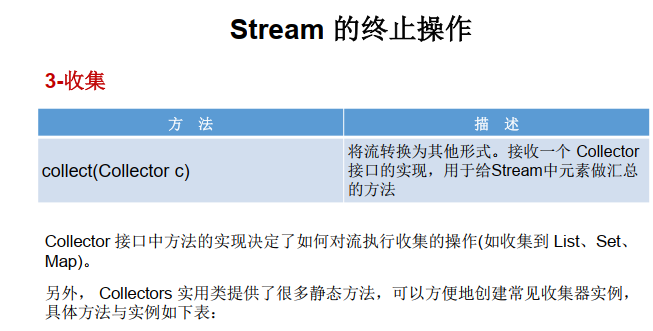
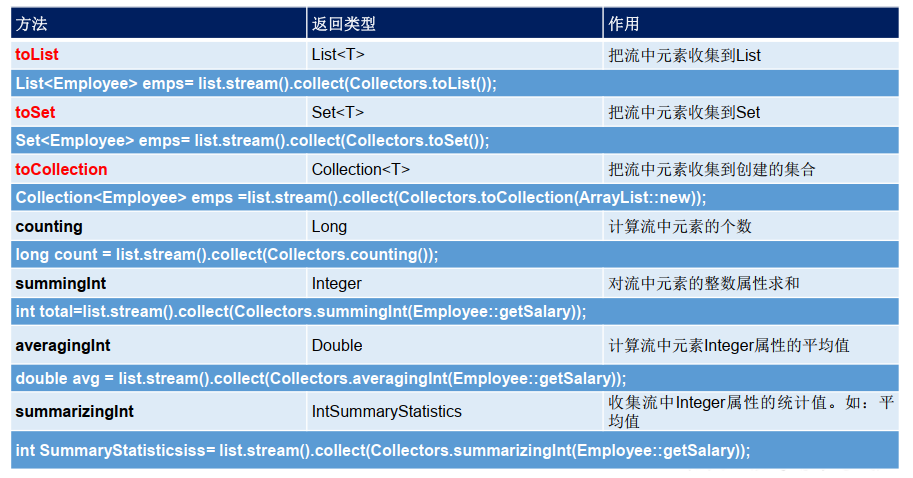
主要使用的是toList和toSet
// collect(Collector c)——将流转换为其他形式。接收一个 Collector接口的实现,用于给Stream中元素做汇总的方法
// Collector 由Collectors调方法生成
// 练习1:查找工资大于6000的员工,结果返回为一个List或Set
List<Employee> employees = EmployeeData.getEmployees();
List<Employee> employeeList = employees.stream().filter(e -> e.getSalary() > 6000).collect(Collectors.toList());
employeeList.forEach(System.out::println);
System.out.println();
Set<Employee> employeeSet = employees.stream().filter(e -> e.getSalary() > 6000).collect(Collectors.toSet());
employeeSet.forEach(System.out::println);
5.Optional类

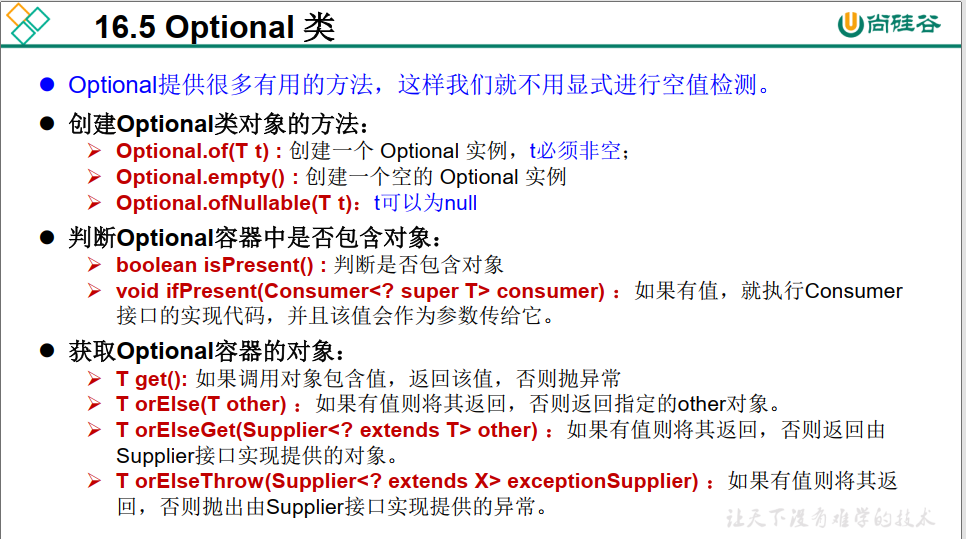
/*
Optional.of(T t) : 创建一个 Optional 实例,t必须非空;
Optional.empty() : 创建一个空的 Optional 实例
Optional.ofNullable(T t):t可以为null
*/
public String getInnerName(Outer outer) {
//可能会报空指针异常 outer为空 或者 getInner()为空
//System.out.println(outer.getInner().getName());
Optional<Outer> outerOptional = Optional.ofNullable(outer);
Outer outer1 = outerOptional.orElse(new Outer(new Inner("tom")));
return outer1.getInner().getName();
}
@Test
public void test1() {
//Outer outer = null;
//Outer outer = new Outer();
// getInnerName(outer);
Outer outer = null;
String name = getInnerName(outer);
System.out.println(name);
}






















 2878
2878

 被折叠的 条评论
为什么被折叠?
被折叠的 条评论
为什么被折叠?








